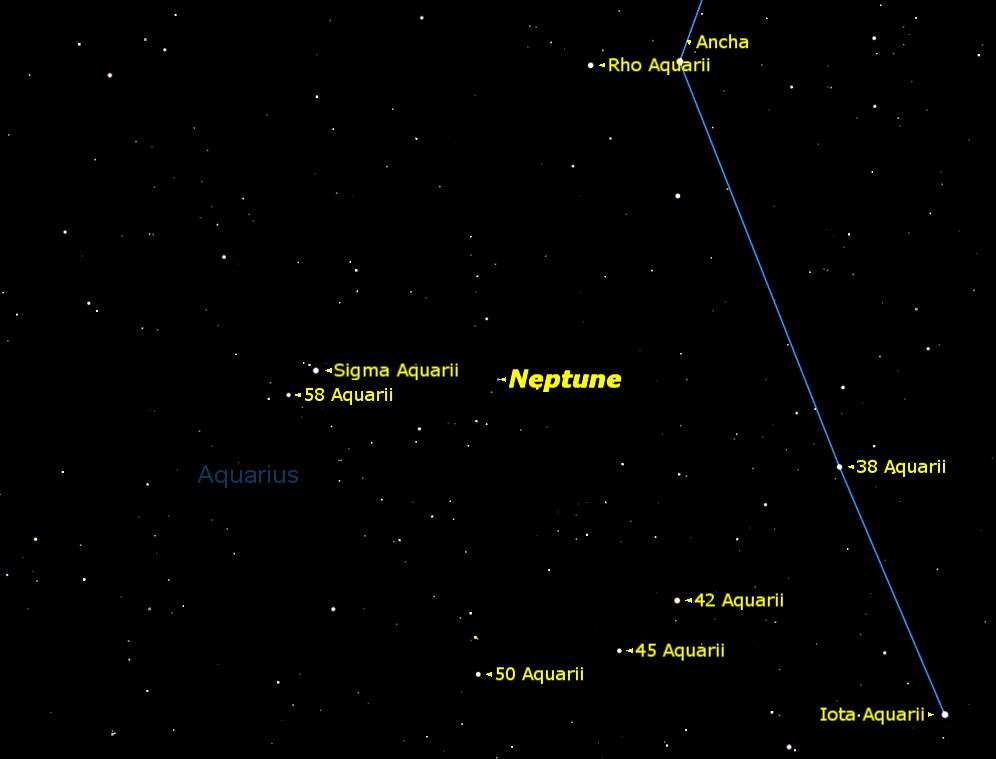Neptune Shines Best in Telescopes Now: See It Online Tonight

The planet Neptune reaches opposition this week and you can catch live telescope views of the blue gas giant planet tonight (Aug. 26) in a special hour-long webcast.
When a planet is in opposition, it lies directly opposite the sun in Earth's sky. It is highest in the sky when the sun is lowest, which is local midnight. When Daylight Saving Time is in effect, this is close to 1 a.m. local time. For Neptune, this orbital milestone will occur on Tuesday (Aug. 27).
You can see live views of Neptune on SPACE.com tonight here in a free one-hour webcast from the online skywatching website Slooh Space Camera. The webcast will begin at 10 p.m. EDT (0200 Aug. 27 GMT) and feature views of Neptune from Slooh's remote-operated observatory in the Canary Islands, off the west coast of Africa. [Photos of Neptune, the Mysterious Blue Planet]
'With the recent finding of yet another new moon around this world, and with its intriguing orbit that causes it to complete three circuits around the sun in the exact same time that Pluto makes two, this Ice Giant is a place that deserves our periodic focus," astronomer Bob Berman, who will participate in the Slooh webcast, said in a statement. "What better occasion than this Monday night line-up, when it ventures to its closest to Earth of 2013? Indeed, it hasn't been this near to us in more than a half century!"
Because Neptune is directly opposite the sun on Tuesday. it rises at the same time as the sun sets, and sets at the same time as the sun rises, so will visible in telescopes all night, weather permitting.
Now that Pluto has been demoted to "dwarf planet" status, Neptune is the most recent full-fledged planet to be discovered, on Sept. 23, 1846, and the farthest planet from the sun, at an average of 2,798,310,157 miles (4,503,443,661 kilometers).
As planets go, Neptune is extremely dim, requiring at least a good set of binoculars to become visible. Even in a powerful telescope, it is a tiny blue-green disk with no detail to be seen. Unless you look carefully, you could easily mistake it for a star.
Get the Space.com Newsletter
Breaking space news, the latest updates on rocket launches, skywatching events and more!
In fact, that happened several times before Neptune's official discovery. Most famously, the 17th century astronomer Galileo Galilee observed Neptune twice while studying Jupiter’s moons in 1612 and 1613, but mistook it for a star both times.
After the discovery of Uranus by William Herschel in 1781, mathematicians calculated the possible location of another planet farther from the sun, but no one looked seriously for it until 1846. The first to actually spot it was German astronomer Johann Gottfried Galle on September 23.
Because it takes Neptune 164 years to circle the sun, it spends an awfully long time in any one constellation. For example, Neptune has been in Aquarius since January 24 2011 and won’t move on into Pisces until May 22 2022. In fact, it has only just completed its first trip around the sun since its discovery, and is again very close to the spot where it was discovered.
Since Neptune is so far from the Earth, it presents too small a disk to be studied well with even the largest telescopes. The only good view we’ve ever gotten of Neptune was in 1989 when the Voyager 2 probe passed within 2740 miles (4400 km.) of Neptune’s cloud tops. At that time it recorded two large blue spots in Neptune’s atmosphere, apparently similar to the Great Red Spot on Jupiter. Voyager 2 also confirmed the existence of a faint ring around Neptune, a ghostly echo of Saturn’s ring system.
This article was provided to SPACE.com by Starry Night Education, the leader in space science curriculum solutions. Follow Starry Night on Twitter @StarryNightEdu. Follow us @Spacedotcom, Facebook and Google+. Original article on SPACE.com.
Join our Space Forums to keep talking space on the latest missions, night sky and more! And if you have a news tip, correction or comment, let us know at: community@space.com.

Geoff Gaherty was Space.com's Night Sky columnist and in partnership with Starry Night software and a dedicated amateur astronomer who sought to share the wonders of the night sky with the world. Based in Canada, Geoff studied mathematics and physics at McGill University and earned a Ph.D. in anthropology from the University of Toronto, all while pursuing a passion for the night sky and serving as an astronomy communicator. He credited a partial solar eclipse observed in 1946 (at age 5) and his 1957 sighting of the Comet Arend-Roland as a teenager for sparking his interest in amateur astronomy. In 2008, Geoff won the Chant Medal from the Royal Astronomical Society of Canada, an award given to a Canadian amateur astronomer in recognition of their lifetime achievements. Sadly, Geoff passed away July 7, 2016 due to complications from a kidney transplant, but his legacy continues at Starry Night.










